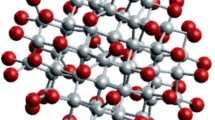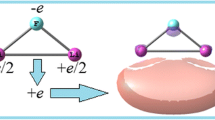Abstract.
The twofold potential of F + color centers at the low coordinated surfaces of SrO for providing tunable laser activity and adsorption properties for atomic halogens (F, Cl and Br) has been investigated using ab initio electronic structure calculations. SrO clusters of variable sizes were embedded in simulated Coulomb fields that closely approximate the Madelung fields of the host surfaces and the nearest neighbor ions to F + were allowed to relax to equilibrium. Based on Stokes shifted optical transition bands and horizontal shifts along the configuration coordinate diagrams, the F + laser activity was found to decrease as the coordination number of the surface ions decreases from 5 (flat) to 4 (edge) to 3 (corner). An attempt has been made to explain this result in terms of Madelung potentials and optical–optical conversion efficiencies. All relaxed excited states are deep below the conduction bands of the perfect ground states, implying that F + is a laser-suitable defect. The most laser active flat surface is the least probable for relaxed excited state orientational destruction of F +. The excited state at the edge has the highest energy, implying exciton (energy) transfer to the flat and edge sites. F + relaxation and defect-formation energies increase with increasing surface coordination number. The Glasner–Tompkins relation between the fundamental optical absorption of F + in solids and the fundamental absorption of the host crystals can be generalized to include the low coordinated surfaces of SrO. The F + color center changes the nature of halogen–surface interaction (adsorption energies) from physical adsorption to chemical adsorption. The halogen–surface interactions increase with increasing electronegativity of the halogen. The calculated adsorption energies can be explained in terms of surface electrostatic potentials, and the covalent spin pairing mechanism plays a dominant role in determining adsorbate–substrate interactions.
Similar content being viewed by others
Author information
Authors and Affiliations
Additional information
Electronic Publication
Rights and permissions
About this article
Cite this article
Shalabi, A. F + tunable laser activity and interaction of atomic halogens (F, Cl and Br) at the low coordinated surface sites of SrO. J Mol Model 8, 314–326 (2002). https://doi.org/10.1007/s00894-002-0100-2
Received:
Accepted:
Issue Date:
DOI: https://doi.org/10.1007/s00894-002-0100-2




